GROWTH RATES IN GDP
The graph below provides a comparison of the quarterly growth rates for chain volume measures of GDP in both seasonally adjusted and trend terms over the last fourteen years. Following the fall in GDP (in seasonally adjusted chain volume terms) in December quarter 2000 there have been 14 consecutive quarters of growth.
Percentage Changes, Chain volume measures
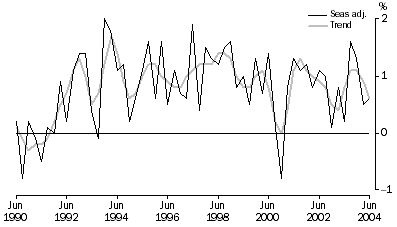
Growth (in seasonally adjusted chain volume terms) over the past 4 quarters has been driven by a continued pattern of strong household final consumption expenditure (up 6.1%), private business investment (up 11.2%) and dwelling investment (up 11.9%). Offsetting these strong contributions was the strong rise in imports of goods and services (up 15.9%). On the industry side, the strongest contributors over the past 4 quarters have been agriculture, forestry, fishing and hunting (up 33.9%), transport and storage (up 11.4%), wholesale trade (up 8.1%), retail trade (up 7.5%), and construction (up 7.3%). Mining fell by 3.1% over the period.
IMPACT OF FARM SEASON ON AUSTRALIAN PRODUCTION
Australia experienced a severe drought in 2002-03 that had a significant impact on the growth of the Australian economy. The direct impact of the 2002-03 drought was a negative contribution of 0.9 percentage points to the volume growth of GDP between 2001-02 and 2002-03.
More favourable weather conditions improved the prospects for the agriculture industry in 2003-04. The ABS has calculated estimates of the impact of the recovery on the agricultural production based on forecasts from ABARE. The most recent forecasts were published on 21 June 2004.
The following table shows, in seasonally adjusted chain volume terms, quarterly data for 2003-04 and forecasts for 2004-05. In 2003-04 there was a much more marked increase in agricultural outputs than in agricultural inputs. The difference between the outputs and inputs is gross agricultural product at market prices. The rise in the estimates of gross agricultural product at market prices between 2002-03 and 2003-04 represents the direct impact on GDP of the recovery following the 2002-03 drought. Gross agricultural product at market prices increased in chain volume terms from $19,075 million in 2002-03 to $24,194 million in 2003-04, a rise of $5,119 million or 26.8%, representing a positive contribution of 0.7 percentage points to the growth in the volume of GDP between 2002-03 and 2003-04.
AGRICULTURAL PRODUCTION, Chain volume measures(a): Seasonally adjusted |
|  |
 | 2003-04
| 2004-05
|  |
 | Sep | Dec | Mar | Jun | Sep(b) | Dec(b) | Mar(b) | Jun(b) |  |
 | $m | $m | $m | $m | $m | $m | $m | $m |  |
|  |
| Outputs | 9,568 | 10,805 | 11,244 | 10,478 | 10,456 | 10,808 | 10,549 | 10,094 |  |
| less inputs | 4,191 | 4,683 | 4,655 | 4,372 | 4,319 | 4,554 | 4,393 | 4,241 |  |
| Gross agricultural product at market prices | 5,377 | 6,122 | 6,589 | 6,106 | 6,137 | 6,254 | 6,156 | 5,853 |  |
| Gross domestic product | 193,220 | 195,772 | 196,697 | 197,904 | na | na | na | na |  |
|  |
| na not available |
| (a) Reference year for chain volume measures is 2002-03. |
| (b) Projections based on ABARE forecasts. |
Based on the most recent ABARE forecasts, the agricultural production from the 2004-05 farm season is projected to be marginally higher than that of the 2003-04 farm season, but making only a negligible contribution to growth in the volume of GDP between 2003-04 and 2004-05.
The graph below, in seasonally adjusted chain volume terms, shows the projected outputs for five major categories of agricultural output. Most of these data are based on ABARE forecasts. The improved performance of the farm sector in 2003-04 was driven by cropping industries, with the output of cereals more than doubling in 2003-04. Caution should be exercised in interpreting the quarterly seasonally adjusted forecasts as revisions to the seasonally adjusted estimates may be expected as additional information becomes available.
Farm output(a), Chain volume measures(b) - Seasonally adjusted
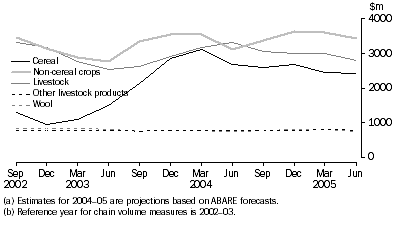
For a complete picture of the impact of the improved farm production on GDP, both the direct and indirect effects of the sector must be considered. Indirect effects can be put into two categories. The first category is the effect on downstream industries, principally transport, wholesale trade and the manufacturing of products from agricultural outputs. The second category comprises the multiplier effects arising from the increased value of production by the agriculture industry and its downstream industries. This has two elements. One arises from any increase in the inputs of these industries which leads to an increase in the production of other Australian industries. The other arises from any increase in factor income of the agriculture and downstream industries that leads to a rise in final expenditures by farmers and others who draw an income from these industries. These indirect effects are described in more detail in a feature article published in the September quarter 2002 issue of this publication.
REAL GROSS DOMESTIC INCOME
A measure of the real purchasing power of income generated by domestic production is the chain volume measure of GDP adjusted for the terms of trade effect, which is referred to as real gross domestic income (see glossary for definition). The graph below provides a comparison of quarterly movements in trend GDP (chain volume measure) and real gross domestic income. During the June quarter, trend real gross domestic income increased by 1.2%, compared to the increase in the trend chain volume measure of GDP of 0.6%, reflecting an improvement in the terms of trade. Trend and seasonally adjusted estimates of real gross domestic income are shown in tables 1 and 2.
PERCENTAGE CHANGES, Trend
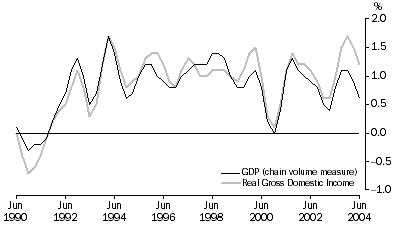
The graph below shows the trend terms of trade over the past fourteen years. The strong rise in the terms of trade since 1999 reflects strong growth in export prices relative to import prices and implies an increase in purchasing power for Australia relative to its trading partners.
Trend, (2002-03 = 100)
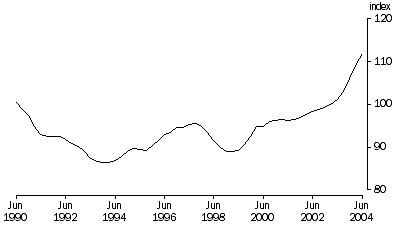
REAL NET NATIONAL DISPOSABLE INCOME
A broader measure of changes in national economic well-being is real net national disposable income. This measure adjusts the chain volume measure of GDP for the terms of trade effect, real net incomes from overseas and consumption of fixed capital (see glossary for definition). The graph below provides a comparison of quarterly movements in trend GDP (chain volume measure) and real net national disposable income. During the June quarter, trend real net national disposable income increased by 1.5%, while the increase in the trend chain volume measure of GDP was 0.6%.
Percentage Changes, Trend
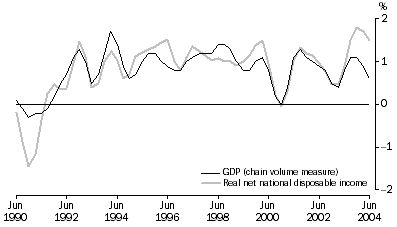
HOUSEHOLD SAVING RATIO
In both trend and seasonally adjusted terms the household saving ratio (see glossary for definition) was negative in the June quarter 2004 implying that household consumption was greater than household disposable income. In trend terms the ratio was -2.3% in the June quarter and in seasonally adjusted terms it was -1.9%. The following graph presents the household saving ratio derived from trend and seasonally adjusted data.
Household saving ratio, Current prices
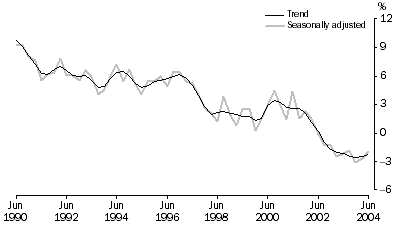
Although seasonally adjusted household saving has been negative over the past two years, net national saving has been positive over the same period. The net national saving ratio in the June quarter 2004 was 4.1% in seasonally adjusted terms.
Caution should be exercised in interpreting the household saving ratio in recent years, because major components of household income and expenditure may still be subject to significant revisions. The impact of these revisions on the saving ratio can cause changes in the apparent direction of the trend.
COMPENSATION OF EMPLOYEES
In June quarter 2004, seasonally adjusted compensation of employees grew by 1.5%, while the seasonally adjusted number of employees recorded in the Labour Force survey grew by 1.3%. Thus, average compensation per employee increased by 0.2%. This follows growth of 0.6% and 1.2% in the previous two quarters. The growth rate over the 12 months to June quarter 2004 was 3.5% (in seasonally adjusted terms) compared to 3.6% growth (in seasonally adjusted terms) in the Wage Cost Index (cat. no. 6345.0) over the same period. (It should be noted that the conceptual bases for the two wage measures are different.)
PRIVATE NON-FARM INVENTORIES TO TOTAL SALES RATIO
In trend current price terms, the book value of private non-farm inventories increased by $1668 million (1.8%) in June quarter 2004, while total sales rose by $3496 million (2.9%). Consequently, the trend inventories to total sales ratio (see glossary for definition) fell from 0.771 in the March quarter 2004 to 0.763 in the June quarter 2004. The following graph presents the ratio of private non-farm inventories to total sales over the last fourteen years.
Trend, Current Prices
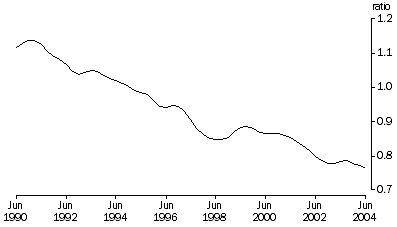
IMPORTS TO DOMESTIC SALES
The imports to domestic sales ratio (see glossary for definition), trended and at current prices, rose from 0.342 in the March quarter 2004 to 0.349 in the June quarter 2004. This reflects a rise of 3.9% in imports of goods accompanied by a 2.0% rise in domestic sales. The following graph presents the ratio of imports to domestic sales over the last fourteen years.
Trend, Current Prices
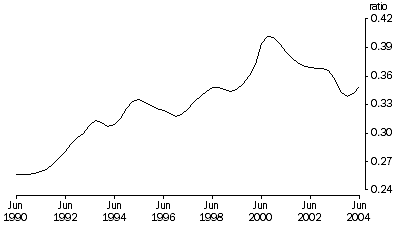
RELIABILITY OF CONTEMPORARY TREND ESTIMATES
Trend estimates are used throughout this publication as an alternative approach to the analysis of movements in time series data. Further details regarding the procedures used to estimate the trend series are described in the Explanatory notes (paragraphs 13 - 17) and in the ABS Information Paper: A Guide to Interpreting Time Series - Monitoring Trends, 2003 (cat. no. 1349.0) released in August 2003.
Potential revisions to trend estimates can be indicated by showing the effects of particular changes in seasonally adjusted estimates that might occur in the next quarter. The table below shows the trend estimates for the last ten quarters and the values to which they would be revised if the given movements in seasonally adjusted GDP actually occurred in September quarter 2004. Seasonally adjusted growth of 0.7% is required in September quarter 2004 to maintain, in September quarter 2004, the trend growth of 0.6% currently estimated for June quarter 2004.
Percentage change in GDP-Chain volume measure |
|  |
 |  |  |  | Trend estimate if seasonally adjusted GDP changes by the following amounts in September qtr 2004
|  |
 |  | Seasonally adjusted GDP as published in Table 2 | Trend GDP as published in Table 1 | Grows by 1.0% | No change | Falls by 1.0% |  |
|  |
| 2002 |  |  |  |  |  |  |
 | March | 0.8 | 1.0 | 1.0 | 1.0 | 1.0 |  |
 | June | 1.1 | 0.9 | 0.9 | 0.9 | 0.9 |  |
 | September | 1.0 | 0.8 | 0.8 | 0.8 | 0.8 |  |
 | December | 0.1 | 0.5 | 0.5 | 0.5 | 0.5 |  |
| 2003 |  |  |  |  |  |  |
 | March | 0.8 | 0.4 | 0.4 | 0.4 | 0.4 |  |
 | June | 0.2 | 0.8 | 0.8 | 0.8 | 0.8 |  |
 | September | 1.6 | 1.1 | 1.1 | 1.1 | 1.1 |  |
 | December | 1.3 | 1.1 | 1.1 | 1.2 | 1.2 |  |
| 2004 |  |  |  |  |  |  |
 | March | 0.5 | 0.9 | 0.8 | 0.8 | 0.7 |  |
 | June | 0.6 | 0.6 | 0.7 | 0.4 | 0.2 |  |
|  |
 Print Page
Print Page
 Print All
Print All